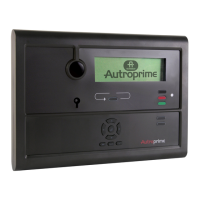System Settings
Configuration Handbook, Autroprime Interactive Fire Detection System, 116-P-APRIME2-CONFIG/EGB, Rev. A, 2013-04-03,
Autronica Fire and Security AS
Page 22
3.9 Automatic Resound
During normal operation:
When pressing the Silence button in the event of an alarm, all fire
alarm devices (FADs) will be deactivated. The red Fire Alarm
indication lamp will switch from a pulsing to a steady light. At this
stage, the resound timer will start. The resound timer will restart on
each operation of the Silence button.
Holding the Silence button down for more than 7 seconds will
activate the Resound function (this message appears in the
information field).
The alarm zones are by default automatically resounded to their
alarm states on timeout (configurable) of the Silence resound timer.
The menu selection Automatic Resound allows you to determine
whether an automatic resound is possible or not. By default,
automatic resound is off (No) and the time delay is set to 12
minutes.
From the Service Menu, perform the following:
Press Enter to select System Settings.
Press the arrow down button to select Automatic Resound, then
press Enter twice.
To select YES, press the right arrow button, then press Enter.
To change the Time Delay, use the Cancel button to delete it,
then type the new one and press Enter.
To confirm the new settings, press Enter once more.
3.10 Detection Zone (DZ) Delay Timers
During normal operation, when the operator panel receives a fire
alarm signal from a point in a Delayed Action detection zone
(configurable), the actioning of outputs to Fire Alarm Devices (FAD)
can be delayed. Also the actioning of outputs to Fire Alarm Routing
Equipment (FARE) can be delayed with the exception of manual call
points.
The delay is divided into two (configurable) delay periods, Initial
delay, T1 and Prolonged Delay, T2.
The default value for T1 is 60 seconds
The default value for T2 is 120 seconds.
The maximum delay (T1 plus T2) is 10 minutes (600 seconds).
The (T1) delay period is started when a Fire Alarm signal from a
point is received. Acti ons will be initiated after the T1 delay period
has expired. Pressing the Prolong Delay button, will terminate T1
and the delay period T2 will start.
From the Service Menu, perform the following:
Press Enter to select System Settings.
Press the arrow down button to select Detection Zone Delay
Timers, then press Enter twice.
To change the delay timers, use the Cancel button to delete the
present T1 Delay Timer (seconds), then type the new one and
press Enter.
Repeat this procedure for the T2 Delay Timer, then press Enter.

